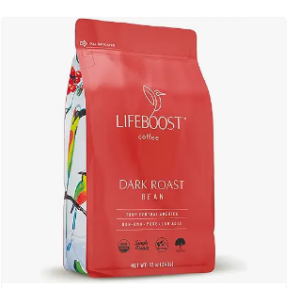Low Acid Coffee For Sensitive Stomachs
 Through personal experiences and the growing popularity of gentler coffee options, we’ll understand why more coffee lovers gravitate towards this alternative
Through personal experiences and the growing popularity of gentler coffee options, we’ll understand why more coffee lovers gravitate towards this alternative
For many, the aroma of freshly brewed coffee signals the day’s start. Yet, for some, this morning indulgence comes with a steep price—discomfort. You understand the jarring sensation of heartburn or a churning stomach after sipping your favourite caffeinated beverage. It’s a common plight.
It’s a concern that hasn’t gone unnoticed. The coffee industry has seen a growing demand for products that promise full-bodied flavour without unwanted side effects. Low-acid coffee emerges as the hero for those of us yearning for that perfect cup that doesn’t lead to regret.
I’ve met numerous people who reluctantly gave up their coffee routine due to acid-related issues. But now, there’s good news. Once sidelined by discomfort, an increasing number of coffee lovers are finding solace in the world of low-acid coffee. This shift isn’t just about trends but finding a blend that can harmonize the love for coffee with physical well-being.
This article introduces you to the concept of low-acid coffee—what it is, why it’s beneficial, and how it provides a reprieve from the acid-related woes often associated with traditional coffee. Through personal experiences and the growing popularity of gentler coffee options, we’ll understand why more coffee lovers gravitate towards this alternative.
In the next section, we’ll confront a standard confusion head-on: the difference between coffee’s perceived acidity and pH level. It’s crucial to grasp this distinction to appreciate what makes a coffee ‘low acid’ and how factors like bean origin, roast, and brewing technique can affect the final cup’s taste and acidity.
Understanding ‘Low Acid’ in Coffee Culture
I’ve noticed a common need to clarify what ‘low acid’ means regarding coffee. You may think it’s about actual pH levels, but it’s more about the taste. Manufacturers try to minimize this taste in low-acid coffee varieties, often described as a sharp or bitter tang.
So, what factors contribute to a coffee’s perceived acidity? First, the origin of the bean is significant. Beans from East Africa, for example, are renowned for their high acidity levels, while those from Brazil typically have a milder profile. The roast level also plays a critical role; dark roasts are less acidic because the longer process breaks down more of the acid.
Another crucial factor to consider is your unique taste sensitivity. Just as some people can handle more heat in their food than others, coffee drinkers have varying tolerances for acidity. This means a coffee that tastes right to me might be too acidic for you, and vice versa.
Your preparation method can also affect acidity. For instance, your daily espresso might be more acidic than a French press brew. Recognizing these variables helps you decide which coffee suits your stomach and taste buds.
Top Low-Acid Coffee Picks for Sensitive Stomachs
I know that a rich cup of coffee is the highlight of some mornings. But for those with sensitive stomachs, this experience can often lead to discomfort. Fortunately, there are options out there to make your days brighter.
- Purity Coffee’s Ease Dark Roast is a fantastic start. It uses a unique roasting process to lower acid levels while keeping those healthy antioxidants we all want. The dark chocolate and caramel notes are a hit among those who’ve tried it, often noting the absence of stomach issues they face with other coffees.
Purity Coffee’s Ease Dark Roast

2. Lifeboost Coffee’s Embolden Dark Roast. Its commitment to ethical sourcing and organic badge stands out here. If you love a rich chocolate flavour in your coffee, this one’s for you. Reviews often highlight its smoothness and how it maintains a luxurious taste without unwanted acidity.

Trücup Born to Be Mild Light Roast offers a fantastic option for a lighter touch. This company specializes in low-acid coffees, allowing even those who usually steer clear of coffee to indulge in its pleasures. Based on what people say, its gentle taste is a major draw, especially for those who find dark roasts too intense.
Volcanica Coffee Low Acid Blend is different, combining beans known for their natural low acidity. This blend is for those who love exploring unique flavours, as the variety creates a smooth coffee experience that’s easy on the stomach.
Finally, for those who are pregnant, breastfeeding, or just looking to cut out caffeine, Mommee Coffee Decaf is a safe bet. It’s crafted with low acidity in mind, using the Swiss Water Process, known for its effectiveness in decaffeination. This is recommended if you want to avoid the caffeine buzz but still crave that coffee taste.
Coffee lovers with sensitive stomachs needn’t compromise on taste or quality. These brands have shown that low-acid coffee can still pack a flavorful punch sans the discomfort. As a bonus, most offer ethical and organic practices, which means your morning cup is easier on your stomach and better for the world.
Guiding Your Low Acid Coffee Journey
Finding your perfect low-acid coffee is a personal quest. I encourage you to consider how your body responds to different coffees.
Don’t hesitate to experiment with various roasts. While dark roasts are typically less acidic, your taste may favour a medium or light roast.
Cold brewing could be your golden ticket. It brings out a smooth, mild flavour; lower acidity makes it easier on the stomach.
Different brewing methods can also affect acidity. A French press or an espresso might offer a different experience than your usual drip coffee.
Take the time to read reviews on low-acid coffee options. Pay close attention to feedback from individuals with sensitivities similar to yours.
Pursuing the perfect cup of low-acid coffee is about listening to your body and refining your coffee routine. Armed with knowledge, patience, and a spirit of discovery, achieving coffee bliss without the bite is more than just a possibility—it’s within your reach.
